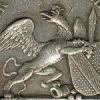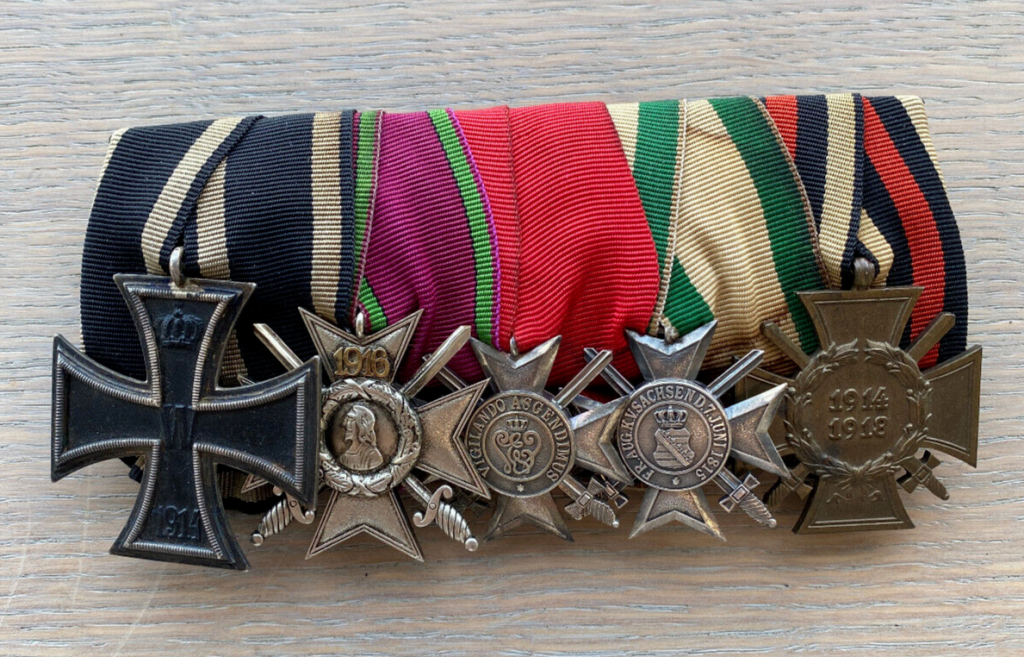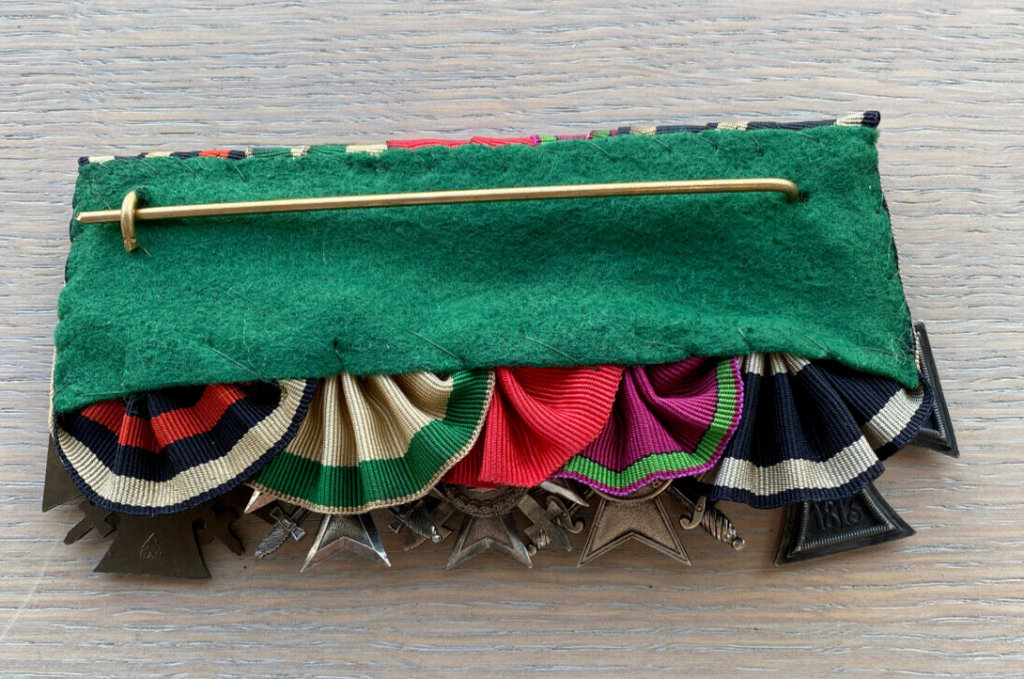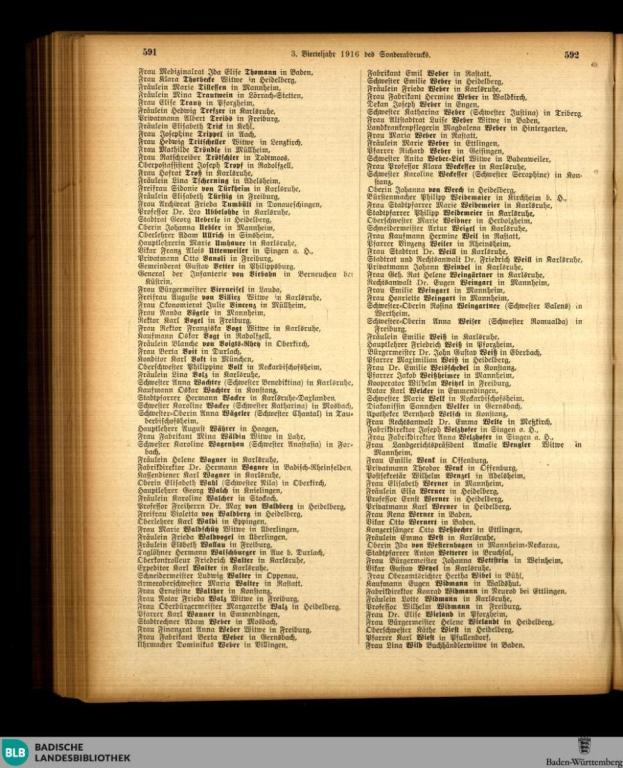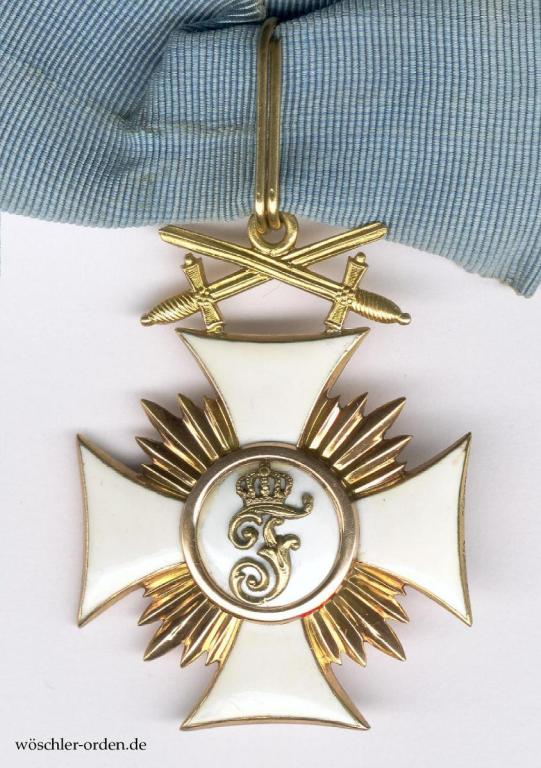-
Posts
3,086 -
Joined
-
Days Won
13
Content Type
Profiles
Forums
Blogs
Gallery
Events
Store
Everything posted by saschaw
-
Not sure if these were actually awarded during the war, or if he would have received it afterward, which, of course, he didn't live to... His knight's cross IInd class was awarded on May 18, 1903 (see here), his knight's cross IInd class with oak leaves on October 24, 1905 (see here) and finally, his knight's cross Ist class with swords on January 5, 1915 (see here). He would wear the higher peacetime award alongside his war decoration on the medal bar...
-
Totally not, no. The wearer was a Prussian officer who started his career in the kingdom of Hanover, which was annexed into Prussia, and he subsequently served with his former enemy. He would probably not receive the long service award until the 1880s. These slight differences that are suitable for dating full-size awards often do not adapt to miniatures. One could call it artistic freedom...
-
I found one minor mistake in the updated list: His Lippe (-Detmold) award was a Grand Cross with swords, not the Ehrenkreuz 1st class. While the cross is technically the same, the class isn't: The 1st class cross is worn as a neck badge, while the Grand Cross is worn on a sash and accompanied by a breast star. This highest class was usually reserved for the ruling Princes of Lippe, but was awarded a (very!) few times to other Royalty.
-
I'm still not sure which shade is the "right" one, or if indeed only one could be the proper one. Hessenthal and Schreiber (p. 171/172) give the ribbon for both the Ehrenzeichen für Kriegsfürsorge and the Kriegsehrenzeichen as "ponceaurot", with the only annotation that a narrower ribbon was used from early 1918 on, apparently due to the war-related shortages. More purple-ish ribbons, though, have been shown here and here... odd!
-
As already pointed out, it's not possible to say if this cross was worn like this, or altered by a Spanish collector. Depending on how you obtained it, though, I don't see too much reason to doubt the mounting's authenticity. Besides the literally tens of thousands to Prussian and other German recipients, there were certainly dozens, if not hundreds of these awarded to Spaniards - both military and civilians, by the way!
-
I do not know how many of his other decorations they have, but Mackensen's Großkreuz des Eisernen Kreuzes is treasured at the Bundesarchiv - Militärarchiv Freiburg i. Br. What is today believed to be a wearer's copy of the same award, and guaranteed to be from the Mackensen family estate, was sold in F. R. Künker's autumn 2019 auction, see here, offered alongside several other (mostly non-phaleristic!) pieces from the same estate, see here.
-
Just curious, what other level would it refer to? The whole regiment? It couldn't be the whole state, because then we'd see things like "Müller XLVII" which doesn't exist, and also would have been extremely impracticable. My company analogy, by the way, stems from Reservisten steins, but it seems to have been a common practice on name-engraved Baden bravery medals as well. I know a "SCHMIDT II" medal, but it wasn't to a second Schmidt recipient of the award...
-
I'm aware of that, but never saw a reason to question that specific information. Siamese awards are usually of concern to me when they're part of Imperial German groups, and it seems almost all pre-WW1 awards to Germans did indeed take place in the older, pre-1909 form. Chulalongkorn ("Rama V"), apparently, had much closer ties to Germany than his son and successor Vajiravudh (Rama VI). Thank you, ThaiDave and webr55, for this most helpful and educating reference to the Southeast Asia subforum! I also took the liberty to merge Stogieman's thread "Back on eBay" into this topic, because it dealt with the v. Cappeln medal bar sold on ebay as well.
-
Interestingly, I can find a Baden Kreuz für freiwillige Kriegshilfe 1914-16 (Kriegshilfekreuz) awarded on September 9, 1916 to (among thousands of other recipients) a General der Infanterie von Viebahn in Berneuchen bei Küstrin - has to be him... I have no idea how he was the only family member to receive a Baden WW1 award!
-
Despite the pictures are rather small, I can add a tiny bit of information: The Friedrichorden is gold and presumably made by court jeweler Eduard Foehr, but the swords aren't! The suspension is nothing like Foehr made them. These swords were added by the Royal Mint Stuttgart, perhaps to a pre-war cross, and are certainly made from gilt silver only. This was a common practice for Württemberg's WW1 orders! See Ulrich Klein and Albert Raff's Die Württembergischen Medaillen von 1864–1933 (einschließlich der Orden und Ehrenzeichen). Stuttgart 2010. p. 463–487. Here's pictures of a "whole-blood" Eduard Foehr piece:
-
The information on his "Karl Friedrich" is perfectly right, as can be seen here... His "Zähringer Lion" seems to date to mid or late 1915, because it can be found here, within a larger group of awards published in the third quarter of 1915. For the actual award date, you'd have to jump a few pages back: it was awarded August 19, 1915. Not sure how other German states handled this, and for how long it lasted, but Iron Crosses can be found in Baden sources as well: His EK1 was published in early 1916, see here. The exact date is not given, though...
-
Now that's a list... I'm most surprised he received two Italian Dynastic awards so close after the end of World War II, but then, after an invitation by King Victor Emmanuel III, he had gone to Italian exile during the Nazi era... I don't have an actual proof for my assumption, but I'd guess the Imtiyaz medal in gold was accompanied by the same silver medal. At least I have seen several royals wearing such a set of two, in both peace and war time. I wanted to provide an exact date, but seemingly, these weren't even published in the Staats-Anzeiger! The Hof- and Staatshandbuch lists him, but with the year only, unfortunately. So nothing to add besides the information this Bertholdorden would be worn as a neck badge and without breast star, just like his Prussian RAO Grand Cross that was awarded additionally to the Black Eagle Order. Talking about that one: His investiture, and thus the award of the collar, dates, according to a manual addition(!) in my 1884 Die Ritter des Königlich Preußischen Hohen Ordens vom Schwarzen Adler und ihre Wappen (1701–1880) by Count Stillfried, p. 70, to January 17, 1900. Awarded January 12, 1915, according to Erhard Roth's Verleihungen von militärischen Orden und Ehrenzeichen des Großherzogtums Baden im Ersten Weltkrieg 1914 – 1918, p. 1.
-
There are plenty of guys selling fraud bars on ebay... if you're referring to this specific one: he wasn't doing medal bars back then. Also, the group discussed here doesn't look anything like his creations, nor does it remind me of a specific other fraudster. That doesn't automatically make it an authentic group, but I still have faith in it!
-
Absolutely, yes. But would he not simply qualify as an "active" Prussian army officer? He was à la suite of Leib-Kürassier-Regiment „Großer Kurfürst“ (Schlesisches) Nr. 1 (see Royal Prussian army rank list, 1914 issue, p. 362), whose uniform he's wearing in this very picture! Only the two in front of the Zentenarmedaille are Bavarian: first one is the 1889 St.-Georgs-Jubiläumsmedaille (see here), and the second one is probably the standard Jubiläumsmedaille für die Armee from 1905. The fourth medal seems to be some British Victorian jubilee medal, and the last one is probably one from Sweden...
-
As said recently, I'm becoming more and more suspicious with the increasing number of ribbon bar fakes around, and it's well possible I'm too suspicious sometimes... I don't like the looks of this one, sorry! I might be wrong (and by the way, I'd prefer to be!), but this would not be one for my collection...
-
91-old-inf-reg is right, that's the most likely scenario. However, there are other possibilities, and I want to add what's second most likely, besides the already mentioned ones: 1) Depending on the recipient's rank, the second ribbon on the upper bar could be either the medal or the cross of Saxe-Meiningen's Ehrenzeichen für Verdienst im Kriege 1914/15. An EM or NCO is generally more likely, of course, but I don't see anything to exclude an officer rank. 2) While the second black and white ribbon on the lower bar is probably a Militär-Ehrenzeichen II. Klasse awarded for the suppression of the native's revolt in Southwest Africa, it could as well be a Militär-Ehrenzeichen I. Klasse from the same conflict, or a (so-called "Goldenes") Militärverdienstkreuz as highest Great War award. Simply impossible to know from a ribbon bar, but we tend to go with the most likely interpretation - and those are, as said, 91-old-inf-reg's.
-
Not quite! According to Michael Autengruber (see here), it actually is the Ehrenkreuz der "Vereinigten drei Oldenburgischen Kammern" Industrie- und Handelskammer, Handwerkskammer und Landwirtschaftskammer. So, the Chamber of Commerce and Industry, the Chamber of Crafts and the Chamber of Agriculture had one joint award!
-
Willi Geile's Im Militär-Wochenblatt veröffentlichte preußische Ordens-Verleihungen. April 1914 bis November 1918. Hagen 1985, p. 3, has a Red Eagle Order Grand Cross with oak leaves and swords published June 12, 1917. Besides the already mentioned awards, there's nothing else from Prussia known. But talking about Hohenzollern, there is an additional princely(!) award: According to the late Richard Lundström's and Daniel Krause's Verleihungen des Fürstlichen Hausordens von Hohenzollern mit Schwertern und der Goldenen Ehrenmedaille mit Schwertern 1914-1947. Konstanz 2008, p. 7, an Ehrenkreuz 1. Klasse mit Schwertern was awarded to v. Gallwitz on February 24, 1917.
-
Your wish is my command! I took the liberty to move your and BlackcowboyBS' comments to this original thread, for further discussion. I agree this one is very, very odd, and an in-hand inspection would be crucial. That being said, I like the combination! Most huge nonsense bars we know consist of common awards, while this group unites quite a number of less common and even some pretty rare decorations. My best guess would be some career soldier, possibly a musician, who left the army in the 1890s and found a civilian engagement with the Prince of Hohenzollern. He was probably no native of Saxon-Weimar, and also never actually received the "XV" cross, but exchanged an older type brooch for that one in 1913/14... A possible scenario? I think so. An authentic group? Who knows... As far as I remember, this bar did never pop up again since it was sold on ebay...



